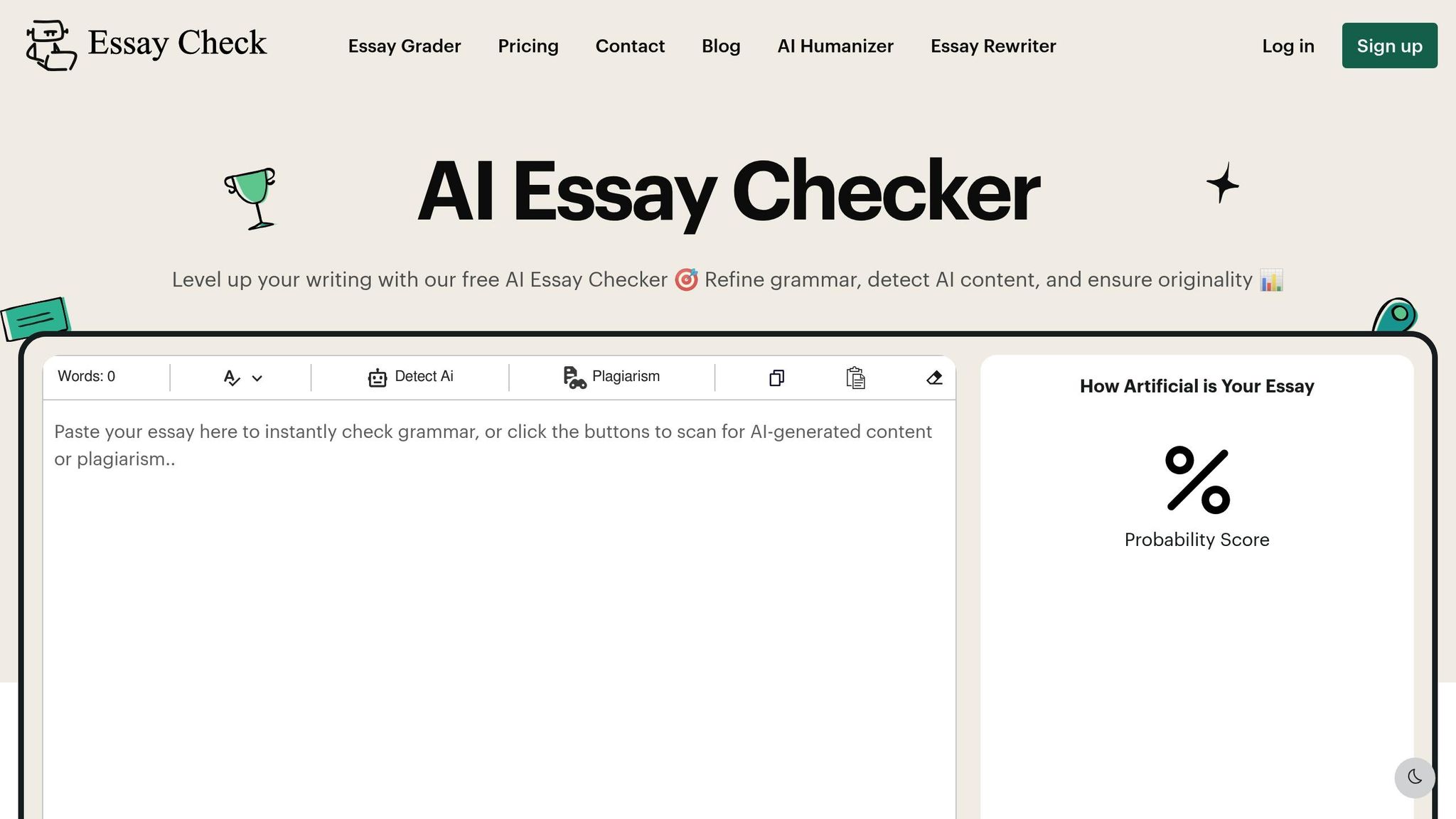Explanatory Essay Examples: Learn by Seeing Real Student Samples
Want to write a clear, informative essay? Explanatory essays break down complex topics into simple ideas using facts and evidence. They don’t argue or persuade - they just explain. Here’s what you’ll learn:
- What is an explanatory essay? A type of writing that explains a topic without bias.
- Why look at examples? To understand structure, tone, and common mistakes.
- Key components: A clear thesis, evidence-based support, and logical organization.
Quick Tip: Use real student examples to see how essays are structured and written effectively. Ready to dive in? Let’s break it down step by step.
Core Elements of Explanatory Essays
Main Components
An effective explanatory essay relies on a few key elements to inform and engage readers. These elements include:
- Clear Thesis Statement: This acts as the essay's roadmap, outlining what you'll explain without taking a stance. For example: "Social media platforms have changed how people communicate and share information in the digital age."
- Evidence-Based Support: Each main point should be backed by reliable evidence. For instance, when discussing World War I, you might explain how militarism, alliances, imperialism, nationalism, and pivotal events contributed to the global conflict.
-
Logical Organization: A well-structured essay keeps readers focused. Typically, this structure includes:
- An introduction with an engaging hook and clear thesis
- Body paragraphs, each addressing one key idea supported by evidence
- A conclusion that reinforces the main points
These components work together to ensure your essay is clear and informative.
Essay Categories
Explanatory essays can take on various forms, depending on their purpose. Here are some common types:
| Essay Type | Purpose | Topic Example |
|---|---|---|
| Process Analysis | Explains how something works or is done | How Search Engines Rank Web Pages |
| Cause and Effect | Explores reasons and outcomes | Impact of Social Media on Mental Health |
| Compare and Contrast | Highlights similarities and differences | Traditional vs. Digital Learning Methods |
| Definition | Offers an in-depth explanation of a concept | Understanding Artificial Intelligence |
| Classification | Categorizes information | Types of Renewable Energy Sources |
Choosing the right essay type depends on your topic. For example, when discussing complex issues like the mental health effects of technology, a cause-and-effect approach works well. Studies show that social media has a dual impact: it fosters connection and community but also contributes to higher rates of anxiety, depression, and isolation among users.
Student Essay Analysis
Basic Essay Format
A solid explanatory essay typically follows a five-paragraph structure. It starts with an introduction that includes a hook to grab attention and a thesis statement to outline the main argument. The body consists of three paragraphs, each focusing on a single idea supported by evidence. Finally, the conclusion ties everything together by summarizing the main points.
Sample Essays
Here are two student essays that demonstrate strong explanatory writing:
- "The Cause and Effects of World War I"
This essay uses a cause-and-effect approach to explain the events leading to World War I. It:
- Introduces a thesis connecting major historical factors
- Backs up ideas with historical evidence
- Maintains an objective and neutral tone
- Clearly links causes to their specific outcomes
The essay focuses on four main factors:
| Factor | Evidence | Impact |
|---|---|---|
| Militarism | Arms race data | Heightened tensions |
| Alliance System | Treaty data | Escalation of conflicts |
| Imperialism | Colonial data | Competition for resources |
| Nationalism | Cultural data | Political instability |
- "The Impact of Social Media on Mental Health"
This essay explores both the positive and negative effects of social media, using findings from recent studies and expert insights to support its claims.
Both essays showcase techniques that strengthen explanatory writing and provide clear, well-supported arguments.
Key Learning Points
Analyzing these essays highlights essential techniques to improve your explanatory writing:
- Use Specific Evidence: Incorporate detailed support like statistics, historical records, or expert opinions instead of vague statements.
- Maintain Neutrality: Present different perspectives fairly, using factual language and balanced evidence to avoid bias.
- Organize Clearly: Start each paragraph with a clear topic sentence, use transitions to connect ideas smoothly, and ensure evidence directly supports your main points.
4 Minute Guide to Expository Essays (Interactive Examples)
sbb-itb-fcf950d
Common Writing Mistakes
Identifying common mistakes can help improve your explanatory writing.
Bias in Writing
Steer clear of personal opinions in explanatory essays. Stick to presenting facts and evidence without adding judgments.
| Biased Writing | Objective Alternative |
|---|---|
| "Social media is destroying our youth" | "Research shows increased social media use correlates with higher anxiety rates among teenagers" |
| "The best solution is..." | "Several potential solutions include..." |
Poor Research
Weak research can hurt your essay's credibility. Common problems include:
- Using outdated sources
- Trusting unreliable websites instead of academic databases
- Selecting evidence to fit a preconceived narrative
- Skipping the fact-checking of statistics
Good research relies on a variety of reputable sources, such as academic journals, government databases, and expert opinions.
Poor Organization
Even with solid research, a poorly organized essay can lose its impact. Watch out for these common issues:
- Scattered Focus: Keep your essay clear and logical from start to finish.
- Weak Transitions: Use connecting phrases to guide readers through your ideas.
| Instead of | Use |
|---|---|
| Abruptly switching topics | "Building on this concept..." |
| Starting new ideas without context | "This development led to..." |
| Jumping between time periods | "Subsequently..." or "Meanwhile..." |
- Inconsistent Structure: Every paragraph should support your thesis while smoothly transitioning to the next idea. This keeps your essay cohesive and easy to follow.
Writing Guidelines
Writing Steps
Here’s how to write an effective explanatory essay:
-
Pick and Research Your Topic
Choose a topic you’re familiar with and gather evidence from trustworthy sources like academic databases, Google Scholar, or government websites. Take note of key details. -
Create a Clear Outline
Plan your essay with a simple outline that includes:- A main thesis statement
- Key points for each body paragraph
- Supporting evidence and examples
- Smooth transitions between sections
-
Write Your Body Paragraphs
Focus on developing your main ideas in the body paragraphs:- Start with a clear topic sentence
- Cover one main idea in each paragraph, supported by evidence
- Use transitions to connect paragraphs smoothly
These steps will help you efficiently use EssayCheck tools when revising your essay.
Using EssayCheck Tools

EssayCheck offers tools to improve your explanatory essay at every stage:
| Tool | Purpose | Best Time to Use |
|---|---|---|
| Grammar Checker | Fix technical errors | During final editing |
| Essay Grader | Get detailed feedback | After the first draft |
| Plagiarism Checker | Ensure originality | Before submission |
Once you’ve used these tools, move on to editing to refine your work further.
Editing Your Essay
Careful editing is key to making your essay clear and polished. Here’s what to focus on:
-
Content Review
- Make sure all concepts are explained clearly.
- Ensure ideas flow logically.
- Provide enough supporting evidence for your points.
-
Technical Edit
- Check grammar and spelling.
- Keep formatting consistent.
- Verify proper citations.
- Ensure smooth transitions between paragraphs.
-
Final Polish
Read your essay out loud to catch awkward phrasing, long sentences, or repeated ideas.
Conclusion
Summary
A strong explanatory essay combines a clear thesis, solid evidence, and well-organized structure. By examining examples from students, it's clear how these elements come together to deliver effective explanations. The best essays share key traits, including:
- An impartial tone free of personal bias
- Thorough coverage of the 5 Ws (Who, What, When, Where, Why)
- Smooth transitions between ideas
- Explanations grounded in evidence
These takeaways can directly enhance your writing process.
Action Plan:
-
Research and Review
Gather information from reliable sources and back up your points with evidence. Use tools like EssayCheck's Essay Grader to get constructive feedback on your draft. -
Outline Your Essay
Organize your ideas with a strong outline that includes:- A compelling opening hook
- A clear thesis statement
- Three to five main points, each supported by evidence
- Logical transitions that connect sections smoothly
-
Draft and Polish
Refine your essay using EssayCheck tools:- Grammar Checker to fix technical errors
- Plagiarism Checker to confirm originality
- Essay Grader to get a comprehensive review
